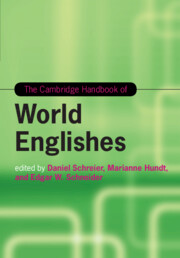Book contents
- The Cambridge Handbook of World Englishes
- Cambridge Handbooks in Language and Linguistics
- The Cambridge Handbook of World Englishes
- Copyright page
- Dedication
- Contents
- Figures
- Maps
- Tables
- Notes on Contributors
- 1 World Englishes: An Introduction
- Part I The Making of Englishes
- Part II World Englishes Old and New
- 7 A Sociolinguistic Ecology of Colonial Britain
- 8 English in North America
- 9 English in the Caribbean and the Central American Rim
- 10 English in Africa
- 11 English in South Asia
- 12 English in Southeast Asia
- 13 World Englishes Old and New: English in Australasia and the South Pacific
- Part III Linguistics and World Englishes
- Part IV Current Challenges
- Index
- References
13 - World Englishes Old and New: English in Australasia and the South Pacific
from Part II - World Englishes Old and New
Published online by Cambridge University Press: 16 December 2019
- The Cambridge Handbook of World Englishes
- Cambridge Handbooks in Language and Linguistics
- The Cambridge Handbook of World Englishes
- Copyright page
- Dedication
- Contents
- Figures
- Maps
- Tables
- Notes on Contributors
- 1 World Englishes: An Introduction
- Part I The Making of Englishes
- Part II World Englishes Old and New
- 7 A Sociolinguistic Ecology of Colonial Britain
- 8 English in North America
- 9 English in the Caribbean and the Central American Rim
- 10 English in Africa
- 11 English in South Asia
- 12 English in Southeast Asia
- 13 World Englishes Old and New: English in Australasia and the South Pacific
- Part III Linguistics and World Englishes
- Part IV Current Challenges
- Index
- References
Summary
Australasia and the Pacific encompass a range of diverse native and non-native Englishes, including contact varieties such as pidgins and creoles. The chapter provides a new approach to these varieties by focusing on their geographical closeness and structural patterns that have the potential of being areal features of Australasian and (South) Pacific Englishes. Owing to the interaction of conditioning factors in language evolution, such features are not only difficult to define but also difficult to trace. Therefore, a significant section of the chapter provides a detailed theoretical discussion on areal features in Australasia and the South Pacific. Finally, three different scenarios are outlined in which the emergence of areal features for at least a number of these varieties seems to be apparent: parallel developments of Australian and New Zealand English; the possible influence of Pasifika Englishes in New Zealand on other varieties; and the effect of similarities in substrate languages, cultural practices, and in the external ecology as a precursor to areal features for ESL, EFL, ethnic varieties, pidgins, and creoles in Australasia and the Pacific.
Keywords
- Type
- Chapter
- Information
- The Cambridge Handbook of World Englishes , pp. 282 - 308Publisher: Cambridge University PressPrint publication year: 2020



